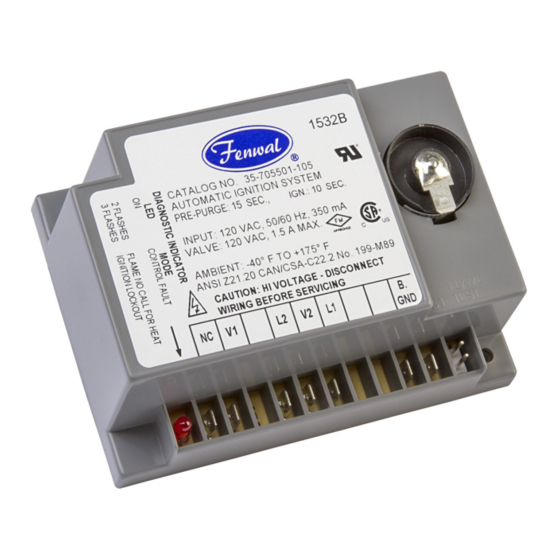Table of Contents
Advertisement
Quick Links
SERIES 35-70
120 VAC Microprocessor-Based
Direct Spark Ignition Control
FEATURES
•
Safe start with DETECT-A-FLAME
technology
•
Custom pre-purge and inter-purge timings
•
Single or three trials for ignition
•
System diagnostic LED
•
Flame current test points
•
Local or remote flame sensing
•
Automatic reset
•
Alarm output (normally closed contact)
•
Open board, potted or enclosure
•
Polarity insensitive flame sensing
APPLICATIONS
•
Commercial cooking
•
Crop dryers
•
Infrared burners
•
Construction and agriculture heaters
•
Other gas-fired appliances
DESCRIPTION
The 35-70 is a 120 VAC direct spark ignition (DSI) control
designed for use in all types of gas-fired appliances. The control
uses a microprocessor circuit to provide precise, repeatable
timing and operating sequences. On-board diagnostics with LED
output makes troubleshooting easy and ensures safe and
efficient operation.
Export Information (USA)
Jurisdiction: EAR
ECCN: EAR99
Agency Certifications
Recognized under the UL component program, UL
R
372. Software certified to ANSI/UL 1998. UL File
MH8817
Design Certified to ANSI Z21.20,
CAN/CSA C22.2 No. 199-M89
FM Approved as both an ignition device and a flame
safeguard. Restricted to single try models without 1
hour reset. TFI time must be 15 seconds or less.
®
flame sensing
SPECIFICATIONS
Input Power
Input Current
Gas Valve
Operating Temperature
Storage Temperature
Flame Sensitivity
Flame Failure Response
Flame Detector Self-check
Rate
Gas Types
Spark Rate:
Size (LxWxH)
with enclosure
Moisture Resistance
Ingress Protection
Tries for Ignition
Trial for Ignition Periods
Pre-purge and Inter-purge
Timings
1
102 to 138 VAC, 50/60 Hz
350 mA @120 VAC with gas valve
relay energized (control only)
1.5A max @ 120 VAC
-40°F to +160°F
(-40°C to +71°C)
-40°F to +185°F
(-40°C to +85°C)
µ
1.0
0.8 seconds maximum
Once per second minimum
Natural, LP, or manufactured
Remote
50/60 sparks/sec
Local
25/30 sparks/sec
5.11 x 3.55 x 2.00 inches
(12.98 x 9.02 x 5.08 cm)
Conformal coated to operate non-
condensing to 95% R.H. Module
should not be exposed to water
Not rated, protection provided by
appliance in which it is installed
One or three try versions available
4, 7, 10, 15 seconds available
0, 5, 15 or 30 seconds available
F-35-70
March 2020
A minimum
Advertisement
Table of Contents

Summary of Contents for Fenwal Controls 35-70 Series
- Page 1 SERIES 35-70 120 VAC Microprocessor-Based Direct Spark Ignition Control F-35-70 March 2020 FEATURES ® • Safe start with DETECT-A-FLAME flame sensing technology • Custom pre-purge and inter-purge timings • Single or three trials for ignition • System diagnostic LED • Flame current test points •...
- Page 2 Operation outside specifications could result in the TFI, the gas valve will immediately de-energize and single failure of the Fenwal Controls product and other try models will enter lockout. On multi-try models, a new TFI equipment with potential for injury to people and WARNING sequence will begin after an inter-purge delay.
- Page 3 TROUBLESHOOTING Wiring Diagrams - 35-70 Troubleshooting Guide Symptom Recommended Actions 1. Control does not start A. Miswired B. No 120VAC at L1 C. Fuse or circuit breaker fault D. Faulty control, check LED for fault codes 2. Thermostat on - no spark A.
- Page 4 Proper Electrode Location Proper location of electrode assembly is important for optimum system performance. The electrode assembly should be located so that the tips are inside the flame envelope and about 1/2-inch (1.2 cm) above the base of the flame as shown: Notes: •...
- Page 5 Reset Method 0 = 1 try, local sense Thermostat / power off reset Consult Fenwal Controls for operating 1 = 1 try, remote sense Thermostat / power off reset characteristics of this control. 2 = 1 try, local sense...



Need help?
Do you have a question about the 35-70 Series and is the answer not in the manual?
Questions and answers